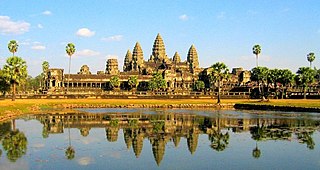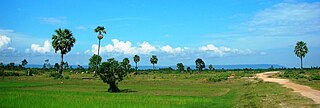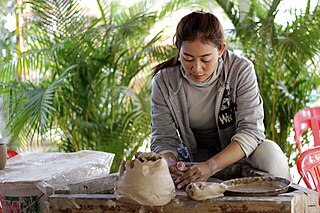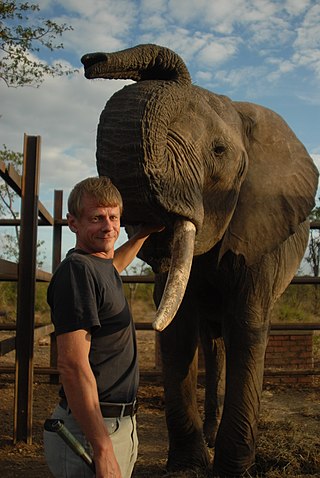
Angkor, also known as Yasodharapura, was the capital city of the Khmer Empire. The city and empire flourished from approximately the 9th to the 15th centuries. The city houses the Angkor Wat, one of Cambodia's most popular tourist attractions.

Angkor Thom, alternatively Nokor Thom, located in present-day Cambodia, was the last and most enduring capital city of the Khmer Empire. It was established in the late twelfth century by King Jayavarman VII. It covers an area of 9 km², within which are located several monuments from earlier eras as well as those established by Jayavarman and his successors. At the centre of the city is Jayavarman's state temple, the Bayon, with the other major sites clustered around the Victory Square immediately to the north. The site is one of the major tourist attractions of Southeast Asia.
Articles related to Cambodia and Cambodian culture include:

Siem Reap, officially Siemreap, is a province (khaet) of Cambodia. It borders the provinces of Oddar Meanchey to the north, Preah Vihear and Kampong Thom to the east, Battambang to the south, and Banteay Meanchey to the west. Its capital and largest city is Siem Reap.
The East Baray, or Yashodharatataka, is a now-dry baray, or artificial body of water, at Angkor, Cambodia, oriented east–west and located just east of the walled city Angkor Thom. It was built around the year 900 AD during the reign of King Yasovarman. Fed by the Siem Reap River flowing down from the Kulen Hills, it was the second-largest baray in the Angkor region and one of the largest handcut water reservoirs on Earth, measuring roughly 7.5 kilometers by 1830 m and holding over 55 million cubic meters of water. Stones bearing inscriptions that mark the construction of the baray have been found at all four of its corners. The labour and organization necessary for its construction were staggering: Its dikes contain roughly 8 million cubic meters of fill.

Siem Reap International Airport was an international airport serving Siem Reap and Angkor. It opened in 1932 and closed in 2023 upon the opening of Siem Reap–Angkor International Airport. It was the second-busiest airport in Cambodia after Phnom Penh International Airport.

Siem Reap is the second-largest city of Cambodia, as well as the capital and largest city of Siem Reap Province in northwestern Cambodia.
The School for Field Studies (SFS) is the United States' largest environmental study abroad program provider for undergraduate college students, offering fully accredited semester- and summer-long academic programs in over 10 countries around the world. SFS students and staff conduct field research, driven by strategic research plans, to address environmental issues which affect both the communities in which the organization operates and the world in general. More than 18,000 students have studied abroad with SFS since it was founded in 1980. SFS is a 501(c)(3) non-profit organization, currently based out of Beverly, Massachusetts.

Hariharalaya was an ancient city and capital of the Khmer empire located near Siem Reap, Cambodia in an area now called Roluos. Today, all that remains of the city are the ruins of several royal temples: Preah Ko, the Bakong, Lolei.

The Phnom Kulen National Park is a national park in Cambodia, located in the Phnom Kulen mountain massif in Siem Reap Province. It was established in 1993 and covers 373.76 km2 (144.31 sq mi). Its official name is Jayavarman-Norodom Phnom Kulen National Park.

Phnom Kulen is a mountain range and a part of Phnom Kulen National Park in Siem Reap Province, Cambodia.
Cambodia Angkor Air is the national flag carrier airline of Cambodia, with its corporate headquarters and main hub in Phnom Penh. The company slogan is "Proudly Serve the Kingdom".

Artisans Angkor is a Cambodian social business creating job opportunities for young people in rural areas, while reviving traditional Khmer craftsmanship.
Mahendraparvata is an ancient city of the Khmer Empire era in Cambodia. The existence of the city has been known for decades, but much of it lay concealed by forest and earth. The city was uncovered by an archaeological expedition led by Jean-Baptiste Chevance and Damian Evans in 2012 with the aid of airborne laser scanning technology called LIDAR.

The Khmer Ceramics & Fine Arts Centre, formerly known as the National Centre for Khmer Ceramics Revival (NCKCR), is an organization aiming to rediscover and reintroduce Khmer ancestral pottery techniques and support the development of contemporary Khmer ceramics art. In the process, the centre creates economic opportunities, helping to decrease poverty in Cambodia. It is located in Siem Reap.

H.E. Tep Hun was a former orchid producer, judge, and minister of justice for Cambodia, during the last years of the Norodom Sihanouk's Sangkum Reastr Niyum regime.

Airavata is a nonprofit organisation founded by Chenda Clais, Professor François-Xavier Roux and Pierre-Yves Clais, protecting the last captive Asian elephants in Ratanakiri Province in Cambodia, as well as protecting up to 100 hectares of the Katieng forest along the river close to the Katieng Waterfalls 10 Kilometer west from the Ratanakiri capitol, Banlung.

Dan Albert John Koehl is a French-Swedish zookeeper, elephant trainer, and stablemaster. An author of the Elephant Encyclopedia, he has been described as "one of Europe's most renowned experts on elephants".
Tep Vattho was an architect, hotel owner, urban planner and director of the urban planning department of the Apsara Authority in Siem Reap, Cambodia.

David-Jaya Piot, born 23rd of August 1996 in Siem Reap, is a French-Cambodian hotelier in Cambodia, president of Siem Reap Chapter of Cambodia Hotel Association, and owner and managing director for the family enterprices Angkor Village Hotel, Angkor Village Apsara Theatre and founder of the elephant retirement park Kulen Elephant Forest.














